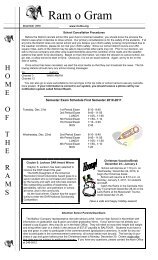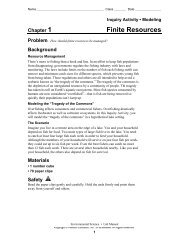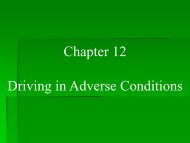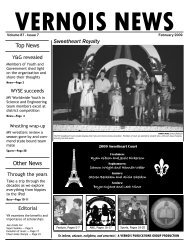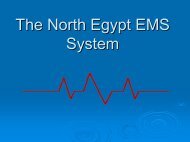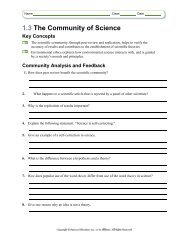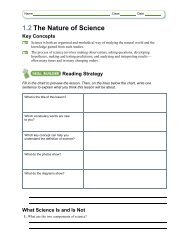9.1 Cellular Growth
9.1 Cellular Growth
9.1 Cellular Growth
Create successful ePaper yourself
Turn your PDF publications into a flip-book with our unique Google optimized e-Paper software.
Chapter 9: Cell<br />
<strong>Growth</strong> & Division
<strong>9.1</strong>Objectives:<br />
1. Explain why cells<br />
are relatively<br />
small.<br />
2. Summarize the<br />
primary stages of<br />
the cell cycle.<br />
3. Describe the<br />
stages of<br />
interpahse.
Chapter 9<br />
<strong>Cellular</strong> Reproduction<br />
<strong>9.1</strong> <strong>Cellular</strong> <strong>Growth</strong><br />
Ratio of Surface Area to Volume
<strong>9.1</strong> <strong>Cellular</strong> <strong>Growth</strong><br />
• As the cell grows, its volume increases<br />
much more rapidly than the surface area.<br />
• The cell might have difficulty supplying<br />
nutrients and expelling enough waste<br />
products.
<strong>9.1</strong> <strong>Cellular</strong> <strong>Growth</strong><br />
Transport of Substances<br />
• Substances move by diffusion or by<br />
motor proteins.<br />
• Diffusion over large distances is slow<br />
and inefficient.<br />
• Small cells maintain more efficient<br />
transport systems.
<strong>9.1</strong> <strong>Cellular</strong> <strong>Growth</strong><br />
<strong>Cellular</strong> Communications<br />
• The need for signaling proteins to move<br />
throughout the cell also limits cell size.<br />
• Cell size affects the ability of the cell<br />
to communicate instructions for cellular<br />
functions.
Cell Division<br />
• Chromosomes – made up of DNA, which<br />
carries the cell’s genetic coded information.<br />
– Cells of every organism have a specific # of<br />
chromosomes:<br />
• Fruit flies = 8 chromosomes<br />
• Humans = 46 chromosomes<br />
• Carrot<br />
= 18 chromosomes
• Before cell division, each<br />
chromosome is replicated<br />
or copied.<br />
• Each chromosome<br />
consists of 2 identical<br />
sister chromatids.<br />
• Each pair of chromatids<br />
are attached at the<br />
centromere, which is<br />
located near the middle of<br />
the chromatids<br />
Cell Division
The Cell Cycle<br />
• Cell division prevents the cell from becoming<br />
too large.<br />
• It also is the way the cell reproduces so that<br />
you grow and heal certain injuries.<br />
• Cells reproduce by a cycle of growing and<br />
dividing called the cell cycle.<br />
• During the cell cycle: a cell grows, prepares<br />
for division, and divides to form 2 daughter<br />
cells, each of which then begins the cycle<br />
again.
The Cell Cycle<br />
• The cell cycle consists of 4 phases: G1, S, G2 & M.<br />
• G1, S & G2 are also known as Interphase.<br />
• Interphase is the normal, functioning phase and not<br />
one of active cell division, however it should be<br />
noted that replication of DNA and the duplication of<br />
the centrosome takes place in interphase--both<br />
necessary before mitosis can take place.
The Cell Cycle<br />
G 1 phase<br />
M phase<br />
S phase<br />
G 2<br />
phase
<strong>9.1</strong> <strong>Cellular</strong> <strong>Growth</strong><br />
• Interphase is the stage during which the<br />
cell grows, carries out cellular functions,<br />
and replicates.<br />
• Mitosis is the stage of the cell cycle during<br />
which the cell’s nucleus and nuclear material<br />
divide.<br />
• Cytokinesis is the method by which a cell’s<br />
cytoplasm divides, creating a new cell.
The Stages of Interphase<br />
• The first stage of interphase, G 1 (1 st growth)<br />
• The cell is growing, carrying out normal cell<br />
functions, and preparing to replicate DNA.<br />
They increase their (size) protoplasm and<br />
synthesize . Some organelles are made as<br />
well.
The Second Stage of Interphase, S-<br />
synthesis phase<br />
• During this period, the chromosomes are replicated.<br />
This means that new DNA material is made. It is an<br />
exact copy of the original DNA material that is in the<br />
nucleus.
The Third Stage of Interphase, G 2, (growth of<br />
parts, 2 nd growth)<br />
• G2 is the phase where final production of organelles<br />
takes place and the cell finishes preparations for cell<br />
division.<br />
• The cell prepares for the division of its nucleus.
• M is the phase where mitosis takes<br />
place. It consists of mitosis and<br />
cytokinesis. It results in two identical<br />
daughter cells being produced.
9.2 Objectives<br />
1. Describe the events of each stage of mitosis.<br />
2. Explain the process of cytokinesis.
Mitosis consists of<br />
• 4 subphases:<br />
– Prophase, Metaphase, Anaphase, and Telophase<br />
• Cytokinesis<br />
– This process occurs during telophase.<br />
– The cytoplasm is divided by the cell membrane.<br />
• Animal cells pinch inward from the edges<br />
• Plant cells build a cell plate between the cells.
9.2 Mitosis and Cytokinesis<br />
The Stages of Mitosis<br />
• Prophase<br />
• The cell’s chromatin tightens.<br />
• Sister chromatids are attached at the<br />
centromere.<br />
• Spindle fibers form in the cytoplasm.
9.2 Mitosis and Cytokinesis<br />
• The nuclear<br />
envelope seems<br />
to disappear.<br />
• Spindle fibers<br />
attach to the sister<br />
chromatids.
9.2 Mitosis and Cytokinesis<br />
Metaphase<br />
• Sister chromatids<br />
are pulled along the<br />
spindle apparatus<br />
toward the center of<br />
the cell.<br />
• They line up in the<br />
middle of the cell.
9.2 Mitosis and Cytokinesis<br />
Anaphase<br />
• The microtubules of the spindle apparatus<br />
begin to shorten.<br />
• The sister chromatids separate.<br />
• The chromosomes move toward the poles<br />
of the cell.
9.2 Mitosis and Cytokinesis<br />
Telophase<br />
• The chromosomes arrive at the poles and<br />
begin to relax.<br />
• Two new nuclear membranes begin to form<br />
and the nucleoli reappear.<br />
• The spindle apparatus disassembles.
9.2 Mitosis and Cytokinesis<br />
Cytokinesis<br />
• In animal cells, microfilaments constrict, or<br />
pinch, the cytoplasm.<br />
• In plant cells, a new structure, called a cell<br />
plate, forms.<br />
Visualizing the<br />
Cell Cycle
Section 10-2<br />
Centrioles<br />
Spindle<br />
forming<br />
Nuclear<br />
envelope<br />
Chromatin<br />
Interphase<br />
Centromere<br />
Prophase<br />
Chromosomes (paired<br />
chromatids)<br />
Spindle<br />
Centriole<br />
Nuclear<br />
envelope<br />
reforming<br />
Cytokinesis<br />
Telophase<br />
Individual<br />
chromosomes<br />
Anaphase<br />
Centriole<br />
Metaphase<br />
Go to<br />
Section:
Section 10-2<br />
Centrioles<br />
Spindle<br />
forming<br />
Nuclear<br />
envelope<br />
Chromatin<br />
Interphase<br />
Centromere<br />
Prophase<br />
Chromosomes (paired<br />
chromatids)<br />
Spindle<br />
Centriole<br />
Nuclear<br />
envelope<br />
reforming<br />
Cytokinesis<br />
Telophase<br />
Individual<br />
chromosomes<br />
Anaphase<br />
Centriole<br />
Metaphase<br />
Go to<br />
Section:
Section 10-2<br />
Centrioles<br />
Spindle<br />
forming<br />
Nuclear<br />
envelope<br />
Chromatin<br />
Interphase<br />
Centromere<br />
Prophase<br />
Chromosomes (paired<br />
chromatids)<br />
Spindle<br />
Centriole<br />
Nuclear<br />
envelope<br />
reforming<br />
Cytokinesis<br />
Telophase<br />
Individual<br />
chromosomes<br />
Anaphase<br />
Centriole<br />
Metaphase<br />
Go to<br />
Section:
Section 10-2<br />
Centrioles<br />
Spindle<br />
forming<br />
Nuclear<br />
envelope<br />
Chromatin<br />
Interphase<br />
Centromere<br />
Prophase<br />
Chromosomes (paired<br />
chromatids)<br />
Spindle<br />
Centriole<br />
Cytokinesis<br />
Telophase<br />
Individual chromatids<br />
Centriole<br />
Metaphase<br />
Nuclear<br />
envelope<br />
reforming<br />
Anaphase<br />
Karyokinesis<br />
Go to<br />
Section:
Section 10-2<br />
Centrioles<br />
Spindle<br />
forming<br />
Nuclear<br />
envelope<br />
Chromatin<br />
Interphase<br />
Centromere<br />
Prophase<br />
Chromosomes (paired<br />
chromatids)<br />
Spindle<br />
Centriole<br />
Nuclear<br />
envelope<br />
reforming<br />
Cytokinesis<br />
Telophase<br />
Individual<br />
chromosomes<br />
Anaphase<br />
Centriole<br />
Metaphase<br />
Go to<br />
Section:
Section 10-2<br />
Centrioles<br />
Spindle<br />
forming<br />
Nuclear<br />
envelope<br />
Chromatin<br />
Interphase<br />
Centromere<br />
Prophase<br />
Chromosomes (paired<br />
chromatids)<br />
Spindle<br />
Centriole<br />
Nuclear<br />
envelope<br />
reforming<br />
Cytokinesis<br />
Telophase<br />
Individual<br />
chromosomes<br />
Anaphase<br />
Centriole<br />
Metaphase<br />
Go to<br />
Section:
Section 10-2<br />
Centrioles<br />
Spindle<br />
forming<br />
Nuclear<br />
envelope<br />
Chromatin<br />
Interphase<br />
Centromere<br />
Prophase<br />
Chromosomes (paired<br />
chromatids)<br />
Spindle<br />
Centriole<br />
Nuclear<br />
envelope<br />
reforming<br />
Cytokinesis<br />
Telophase<br />
Individual<br />
chromosomes<br />
Anaphase<br />
Centriole<br />
Metaphase<br />
Go to<br />
Section:
Mitosis Foldable
Objectives:<br />
1. Describe what<br />
happens during the<br />
four phases of<br />
mitosis.
Interphase<br />
Cell membrane<br />
Nuclear<br />
membrane<br />
Chromatin<br />
material<br />
Nucleolus<br />
Centrosome<br />
Cell Membrane
Interphase<br />
• G1 – cell growth<br />
• S – DNA replication<br />
• G2 – Prepares for mitosis
Prophase<br />
Chromosome<br />
Spindle fibers
Prophase<br />
• 1. Chromatin condensed into chromosomes<br />
• 2. Nucleolus fades and disappears<br />
• 3. Centrosomes divides forming 2 centrioles<br />
• 4. Nuclear membrane fades and disappears
Metaphase<br />
Chromosomes<br />
Spindle<br />
Fibers
Metaphase<br />
• 1. Chromosomes in middle of cell<br />
• 2. Nuclear membrane and nucleolus are gone<br />
• 3. Spindle fibers formed and attach to<br />
chromosomes
Anaphase<br />
Membrane<br />
Pinches in<br />
Animal cell<br />
Chromatids
Anaphase<br />
• 1. Chromosomes separate as chromatids move<br />
to opposite ends of cell = Karyokinesis<br />
• 2. Plasma membrane pinches inward in animal<br />
cell<br />
• Plant Cell<br />
• 3. Cell plate develops - no pinching<br />
• 4. Lacks centrioles
Telophase<br />
Pinching of the cell<br />
membrane<br />
Nucleolus<br />
Chromatin<br />
Nuclear<br />
Membrane<br />
Centrioles<br />
Cell Membrane
Telophase<br />
• 1. Nuclear Membrane and nucleolus reform<br />
• 2. One centriole in each new cell
Cytokinesis<br />
Cell Membrane<br />
Nucleolus<br />
Chromatin<br />
Nuclear<br />
Membrane<br />
Centrioles
Cytokinesis<br />
• 1. Cytoplasm pinches in half with each<br />
daughter cell having identical set of<br />
chromosomes<br />
• 2. Plant Cell creates a cell plate dividing the cell<br />
into daughter cells having identical set of<br />
chromosomes
Quiz 12/11/09<br />
YOU HAVE 5 MINUTES TO PREPARE FOR YOUR<br />
POP QUIZ
Quiz<br />
1. What are the 3 stages of Interpahse? What<br />
happens in each?<br />
2. What are the stages of mitosis in order?<br />
3. What stage of mitosis do the chromosomes<br />
line up in the middle of the cell?<br />
4. What stages does Karyokinesis occur?<br />
5. What stage does the cytoplasm divided?
9.3 Objectives<br />
1. Summarize the role of cycline proteins in<br />
controlling the cell cycle.<br />
2. Explain how cancer relates to the cell cycle.<br />
3. Describe the role f apoptosis.<br />
4. Summarize the two types of stem cells and<br />
their potential uses.
9.3 Cell Cycle Regulation<br />
Normal Cell Cycle<br />
• Different cyclin/CDK<br />
combinations signal<br />
other activities,<br />
including DNA<br />
replication, protein<br />
synthesis, and nuclear<br />
division throughout the<br />
cell cycle.
9.3 Cell Cycle Regulation<br />
Quality Control Checkpoints<br />
• The cell cycle has built-in checkpoints that<br />
monitor the cycle and can stop it if something<br />
goes wrong.<br />
• Spindle checkpoints also have been identified<br />
in mitosis.
9.3 Cell Cycle Regulation<br />
Abnormal Cell Cycle: Cancer<br />
• Cancer is the<br />
uncontrolled growth<br />
and division of cells.<br />
• Cancer cells can kill<br />
an organism by<br />
crowding out normal<br />
cells, resulting in the loss of tissue function.
9.3 Cell Cycle Regulation<br />
Causes of Cancer<br />
• The changes that occur in the regulation of<br />
cell growth and division of cancer cells are<br />
due to mutations.<br />
• Various environmental factors can affect the<br />
occurrence of cancer cells.
9.3 Cell Cycle Regulation<br />
Apoptosis<br />
• Programmed cell death<br />
• Cells going through apoptosis actually shrink<br />
and shrivel in a controlled process.
9.3 Cell Cycle Regulation<br />
Stem Cells<br />
• Unspecialized cells<br />
that can develop into<br />
specialized cells<br />
when under the right<br />
conditions
9.3 Cell Cycle Regulation<br />
Embryonic Stem Cells<br />
• After fertilization, the resulting mass of cells<br />
divides repeatedly until there are about<br />
100–150 cells. These cells have not become<br />
specialized.
9.3 Cell Cycle Regulation<br />
Adult Stem Cells<br />
• Found in various tissues in the body and<br />
might be used to maintain and repair the<br />
same kind of tissue<br />
• Less controversial because the adult stem<br />
cells can be obtained with the consent of<br />
their donor<br />
<strong>Cellular</strong><br />
Reproduction



